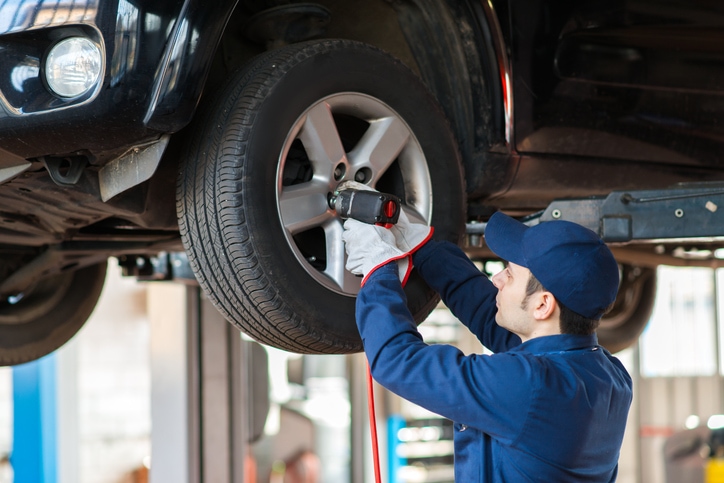All Categories
Featured
Tire turnings are just one of the easiest yet most efficient maintenance tasks to guarantee your automobile runs efficiently and safely. This routine solution redistributes tire wear, supplying numerous advantages for your cars and truck's efficiency, safety and security, and your budget.
What Does Tire Turning Involve?
Tire rotation is the process of occasionally changing the placement of each tire on your vehicle. For example, front tires might be swapped with rear ones, or tires might be moved diagonally. The certain pattern relies on variables like your car's drivetrain (front-wheel, rear-wheel, or all-wheel drive) and the sort of tires you have.
![]()
Why Tire Turnings Are Crucial
Promotes Even Step Use. Different tires birth different quantities of weight and tension depending upon their position. Since they manage braking and guiding, front tires frequently use faster. Normal turnings cancel the wear, making certain all 4 tires have similar step depths.
Prolongs Tire Lifespan. Unequal wear causes early tire replacements. Revolving your tires can extend their life expectancy, conserving you money gradually.
Enhances Vehicle Efficiency. Well balanced tires boost stability, dealing with, and traction. Whether you're collaring, stopping, or driving on slippery roadways, equally used tires guarantee a smoother and more secure driving experience.
![]()
Improves Fuel Efficiency. Tires with uneven tread wear can create much more rolling resistance, which makes your engine job harder and takes in extra gas. Regular rotations assist keep optimal fuel performance.
Makes Certain Security. Worn tires can compromise braking distance and control. By rotating your tires, you preserve also wear and decrease the threat of blowouts or skidding.
Exactly How Typically Should You Rotate Your Tires?
Experts recommend turning your tires every 5,000 to 7,500 miles. A hassle-free strategy is to pair tire turnings with oil modifications. Constantly consult your lorry's owner guidebook for certain guidelines.
Common Rotation Patterns
Turning patterns depend on your lorry's drivetrain and tire kind:
Front-Wheel Drive (FWD): Front tires transfer to the back, and rear tires cross to the front.
Rear-Wheel Drive (RWD): Back tires relocate to the front, and front tires cross to the back.
Four-wheel Drive (AWD): Tires comply with an "X" pattern to make sure balanced wear.
Directional Tires: These tires have to stay on the same side of the car and are exchanged front to back.
Indications Your Tires Need Rotation
Unequal walk wear.
![]()
Lowered fuel effectiveness.
Vibrations while driving, especially at high rates.
Difficulty handling the vehicle in negative weather.
Final Thoughts
Tire rotations are an easy means to secure your financial investment and enhance your driving experience. By redistributing wear, you can prolong the life of your tires, improve gas effectiveness, and ensure your safety on the roadway. Schedule normal tire turnings with a trusted mechanic and make it a regular part of your lorry's upkeep regimen.
What Does Tire Turning Involve?
Tire rotation is the process of occasionally changing the placement of each tire on your vehicle. For example, front tires might be swapped with rear ones, or tires might be moved diagonally. The certain pattern relies on variables like your car's drivetrain (front-wheel, rear-wheel, or all-wheel drive) and the sort of tires you have.

Why Tire Turnings Are Crucial
Promotes Even Step Use. Different tires birth different quantities of weight and tension depending upon their position. Since they manage braking and guiding, front tires frequently use faster. Normal turnings cancel the wear, making certain all 4 tires have similar step depths.
Prolongs Tire Lifespan. Unequal wear causes early tire replacements. Revolving your tires can extend their life expectancy, conserving you money gradually.
Enhances Vehicle Efficiency. Well balanced tires boost stability, dealing with, and traction. Whether you're collaring, stopping, or driving on slippery roadways, equally used tires guarantee a smoother and more secure driving experience.

Improves Fuel Efficiency. Tires with uneven tread wear can create much more rolling resistance, which makes your engine job harder and takes in extra gas. Regular rotations assist keep optimal fuel performance.
Makes Certain Security. Worn tires can compromise braking distance and control. By rotating your tires, you preserve also wear and decrease the threat of blowouts or skidding.
Exactly How Typically Should You Rotate Your Tires?
Experts recommend turning your tires every 5,000 to 7,500 miles. A hassle-free strategy is to pair tire turnings with oil modifications. Constantly consult your lorry's owner guidebook for certain guidelines.
Common Rotation Patterns
Turning patterns depend on your lorry's drivetrain and tire kind:
Front-Wheel Drive (FWD): Front tires transfer to the back, and rear tires cross to the front.
Rear-Wheel Drive (RWD): Back tires relocate to the front, and front tires cross to the back.
Four-wheel Drive (AWD): Tires comply with an "X" pattern to make sure balanced wear.
Directional Tires: These tires have to stay on the same side of the car and are exchanged front to back.
Indications Your Tires Need Rotation
Unequal walk wear.

Lowered fuel effectiveness.
Vibrations while driving, especially at high rates.
Difficulty handling the vehicle in negative weather.
Final Thoughts
Tire rotations are an easy means to secure your financial investment and enhance your driving experience. By redistributing wear, you can prolong the life of your tires, improve gas effectiveness, and ensure your safety on the roadway. Schedule normal tire turnings with a trusted mechanic and make it a regular part of your lorry's upkeep regimen.
Latest Posts
Explore Montclare Auto Repair’s Premier Car Care Solutions and Why Drivers Choose Them
Published May 28, 25
1 min read
Explore Best Auto Repair Care in Chicago – Drive with Confidence
Published May 25, 25
1 min read
Reputable Industrial Roofing Services by Weathercraft
Published May 24, 25
1 min read